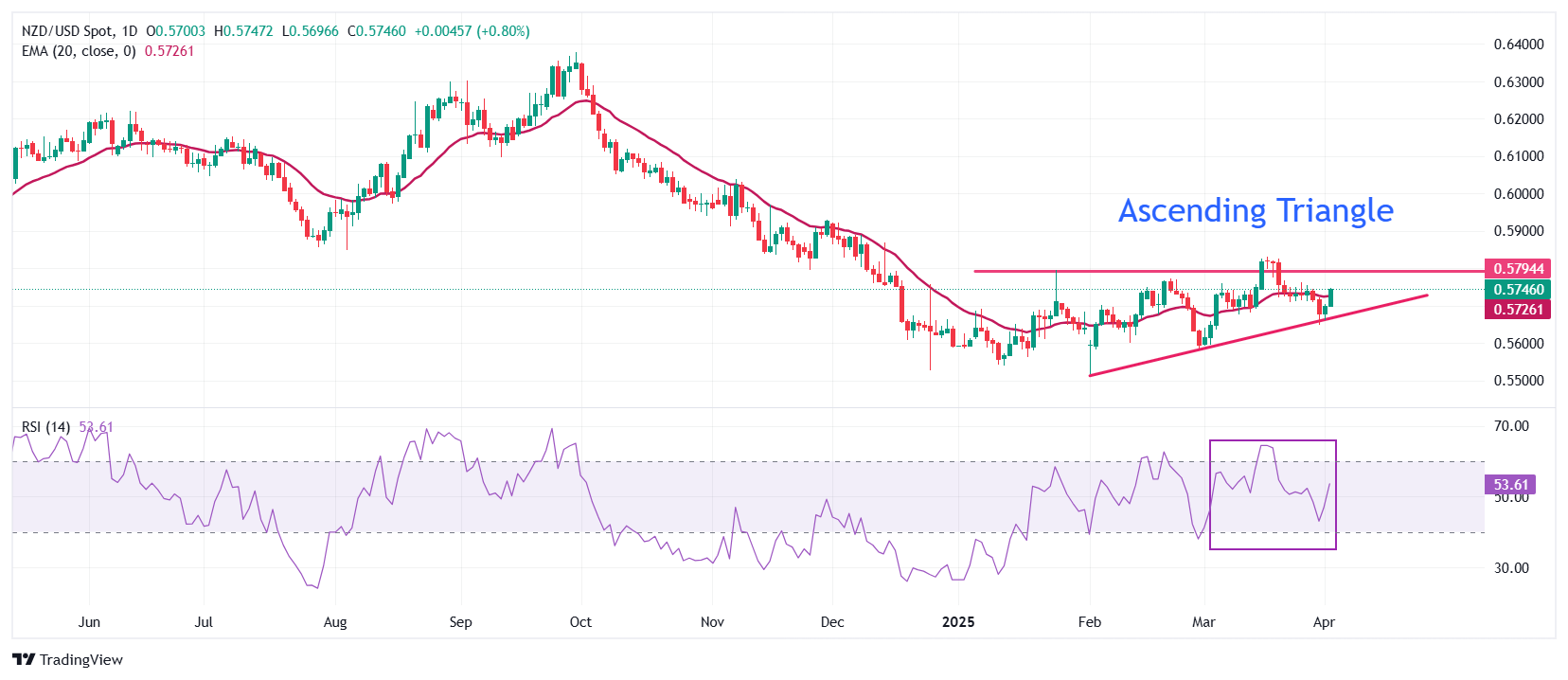April 02, 2025
- The NZD/USD has jumped at around 0.5750 as the antipodians have surpassed before Trump’s tariff announcement.
- Donald Trump is expected to announce a lot of tariffs for China.
- Trump’s tariff will be bad for the global economy, including the United States.
The NZD/USD pair reached closer to 0.5745 during the European business on Wednesday. The Kiwi pair strengthens because the antipodians are surpassing their peers despite the hope that they will be damaged by the US (US), which will announce after President Donald Trump.
New Zealand dollar prices today
The table below shows the change in New Zealand Dollar (NZD) per cent against the main currency listed today. New Zealand Dollar was the most powerful against the Canadian dollar.
| USD | Eur | GBP | JPY | Cad | Audience | NZD | CHF | |
|---|---|---|---|---|---|---|---|---|
| USD | -0.09% | -0.16% | -0.15% | 0.08% | -0.49% | -0.76% | 0.05% | |
| Eur | 0.09% | -0.04% | -0.06% | 0.19% | -0.38% | -0.68% | 0.16% | |
| GBP | 0.16% | 0.04% | 0.02% | 0.23% | -0.33% | -0.61% | 0.20% | |
| JPY | 0.15% | 0.06% | -0.02% | 0.21% | -0.37% | -0.65% | 0.17% | |
| Cad | -0.08% | -0.19% | -0.23% | -0.21% | -0.57% | -0.83% | -0.03% | |
| Audience | 0.49% | 0.38% | 0.33% | 0.37% | 0.57% | -0.28% | 0.53% | |
| NZD | 0.76% | 0.68% | 0.61% | 0.65% | 0.83% | 0.28% | 0.82% | |
| CHF | -0.05% | -0.16% | -0.20% | -0.17% | 0.03% | -0.53% | -0.82% |
The map of the heat shows the percentage of the main coin against each other. The base coin is picked from the left column, while the quote is picked from the top row of the coin. For example, if you pick up New Zealand dollars from the left column and move to the US dollar along the horizontal line, the percentage shown in the box will present the NZD (base)/USD (quote).
Market participants are hoping that Trump will return to the White House that he will be able to hit a lot of tariffs in China, in addition to 20% of the customs applied. China as the largest trade partner in the United States will weaken its economic outlook on higher import tariffs in China.
The impact of Trump’s tariff will be indirect on the New Zealand Dollar (NZD), which is why the KIW economy depends significantly on export to the United States.
Meanwhile, US dollar (US dollar) business with caution before Trump’s tariff is announced. Investors are hoping that Trump’s new tariff new suit will also affect US economic growth and resurrect inflation in the nearest term.
NZD/USD does business within the formation of the triangle on the daily timeframe, suggests the inevitability among the market participants. The flat boundary of the chart pattern mentioned above is plotted from the height of 0.5795 from the height of January 26, while the Ward OPLu boundary is placed below 0.5516 below February.
The 20 -day Xphiological Moving average (EMA) is submerged near the pair near about 0.5725, which indicates the trend of the side path.
The relative energy index of the 14-day (RSI) rockers inside 40.00-60.00, which indicates an instability contraction.
If the asset breaks the height of the March of 0.5832, an reverse step will appear, which will drive it to Round-level resistance of 0.5900 and on 29th November.
On the flip, the kiwi pair can rewrite below the lower 0.5470 of the 13 -year -old, and if it breaks below 0.5516 below February, the circular level of 0.5400 may be closer to support.
NZD/USD Daily Chart

US-China Faqs of the Battle of Commerce
Generally speaking, a trade war between two or more countries is an economic conflict due to extreme security on one end. It refers to the creation of trade barriers, such as tariffs, which causes counter-barrier, increase import costs and therefore costs living.
An economic conflict between the United States and the United States of the United States and China began early 2018, when President Donald Trump had set up trade barriers to China, claiming that the Asian giant demanded wrong commercial practice and theft of intellectual property. China took revenge action by imposing tariffs on multiple US products such as automobile and soybeans. Tensions increased until the signing of the two countries US-China Phase One Trade Deal in January 2021. The agreement requires structural reforms and other changes in China’s economic and trade systems and pretended to restore stability and confidence between the two countries. However, the Coronavirus epidemic took the focus from the conflict. Nevertheless, it is worth mentioning that President Joe Biden, who took over after Trump, kept duty and even added some additional tariffs.
The 47th US President has spread a new wave of tensions between the two countries as Donald Trump returns to the White House. During the 2021 election campaign, Trump pledged to impose a% tariff on China after China returned to the office, which he made on January 28, 2021. With the return of Trump, the global economic landscape affects the global supply, affecting the global economic landscape in the presidency, including the tat-tat policy that affects theoretical policies, where it left.
